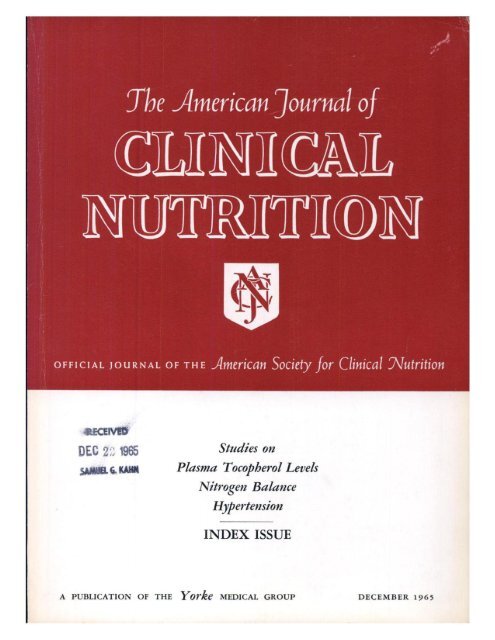超加工食品消费、炎症指数水平和自杀企图风险:一项前瞻性队列研究的结果
IF 6.9
1区 医学
Q1 NUTRITION & DIETETICS
引用次数: 0
摘要
背景自杀企图是一个重大的公共卫生问题,许多案例是可以预防的。然而,饮食模式的影响仍未得到充分研究。目前,超加工食品(upf)消费量的增加与各种健康问题有关,包括可能增加SA风险的精神健康障碍。目的探讨UPF消费与SA之间的关系,并探讨SA相关炎症指数水平的中介作用。方法本研究纳入了2006年至2010年从英国生物银行队列中招募的208,938名参与者。采用Cox比例风险模型评估UPF摄入体重比例与SA事件之间的关系。进行了替代分析,以评估用未加工或最低限度加工食品(unpf)替代UPF时SA的风险。进一步进行了因果中介分析,以估计炎症指数水平在这种关联中的中介作用。结果在13.1年的中位随访中,共发现545例SA事件。与UPF消费最低五分位数的参与者相比,最高五分位数的参与者发生SA的风险高出1.63倍[风险比(HR): 1.63, 95%置信区间(CI): 1.23, 2.15]。此外,UPF摄入量每增加一个SD, SA的风险增加20% (HR: 1.20, 95% CI: 1.11, 1.29)。值得注意的是,用UNPF代替20%的UPF重量与SA风险降低23%有关(HR: 0.77, 95% CI: 0.69, 0.85)。此外,在因果中介分析中,炎症指数水平介导了UPF消费与SA之间0.7%-1.5%的关联。结论较高的UPF消费与SA风险增加相关,部分由炎症指数水平介导。用UNPF代替UPF可显著降低SA发病率,这突出了过渡到含有较高UNPF摄入量的饮食的潜在益处。本文章由计算机程序翻译,如有差异,请以英文原文为准。
Ultraprocessed foods consumption, inflammatory index levels, and risk of suicide attempt: findings from a prospective cohort study
Background
Suicide attempts (SAs) are a major public health issue, with many cases being preventable. However, the impact of dietary patterns remains inadequately studied. Currently, the rising consumption of ultraprocessed foods (UPFs) has been linked to various health issues, including mental health disorders that may increase risk of SA.
Objectives
This study aimed to investigate the association between UPF consumption and SA, and explore the mediating role of SA-related inflammatory index levels.
Methods
This study included 208,938 participants from the UK Biobank cohort, recruited from 2006 to 2010. Cox proportional hazards models were used to assess the association between the weight proportion of UPF intake and incident SA. Substitution analyses were conducted to evaluate risk of SA when replacing UPF with unprocessed or minimally processed foods (UNPFs). Causal mediation analyses were further conducted to estimate the mediating effects of inflammatory index levels in this association.
Results
Over a median follow-up of 13.1 y, 545 SA events were identified. Compared with participants in the lowest quintile of UPF consumption, those in the highest quintile had a 1.63 times higher risk of developing SA [hazard ratio (HR): 1.63, 95% confidence interval (CI): 1.23, 2.15]. Additionally, each SD increase in UPF consumption was associated with a 20% higher risk of SA (HR: 1.20, 95% CI: 1.11, 1.29). Notably, replacing 20% of UPF weight with UNPF was linked to a 23% reduction in SA risk (HR: 0.77, 95% CI: 0.69, 0.85). Furthermore, in causal mediation analyses, inflammatory index levels mediated 0.7%–1.5% of the association between UPF consumption and SA.
Conclusions
Higher UPF consumption is associated with an increased risk of SA, partially mediated by inflammatory index levels. Replacing UPF with UNPF significantly reduces SA incidence, highlighting potential benefits of transitioning to a diet with higher UNPF consumption.
求助全文
通过发布文献求助,成功后即可免费获取论文全文。
去求助
来源期刊
CiteScore
12.40
自引率
4.20%
发文量
332
审稿时长
38 days
期刊介绍:
American Journal of Clinical Nutrition is recognized as the most highly rated peer-reviewed, primary research journal in nutrition and dietetics.It focuses on publishing the latest research on various topics in nutrition, including but not limited to obesity, vitamins and minerals, nutrition and disease, and energy metabolism.
Purpose:
The purpose of AJCN is to:
Publish original research studies relevant to human and clinical nutrition.
Consider well-controlled clinical studies describing scientific mechanisms, efficacy, and safety of dietary interventions in the context of disease prevention or health benefits.
Encourage public health and epidemiologic studies relevant to human nutrition.
Promote innovative investigations of nutritional questions employing epigenetic, genomic, proteomic, and metabolomic approaches.
Include solicited editorials, book reviews, solicited or unsolicited review articles, invited controversy position papers, and letters to the Editor related to prior AJCN articles.
Peer Review Process:
All submitted material with scientific content undergoes peer review by the Editors or their designees before acceptance for publication.

 求助内容:
求助内容: 应助结果提醒方式:
应助结果提醒方式:


